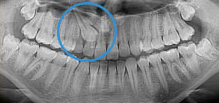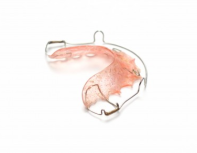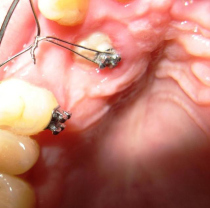Impacted Tooth

An impacted tooth is one that fails to erupt into the dental arch within the expected developmental window. Because impacted teeth do not erupt, they are retained throughout the individual's lifetime unless extracted or exposed surgically. Teeth may become impacted because of adjacent teeth, dense overlying bone, excessive soft tissue or a genetic abnormality. Most often, the cause of impaction is inadequate arch length and space in which to erupt. That is the total length of the alveolar arch is smaller than the tooth arch (the combined mesiodistal width of each tooth).
The wisdom teeth (third molars) are frequently impacted because they are the last teeth to erupt in the oral cavity. Mandibular third molars are more commonly impacted than their maxillary counterparts. As a general rule, all impacted teeth must be removed, except canine teeth;canines do not need surgery and may just remain buried and give no further problems. Classification Classifications enable the oral surgeon to determine the difficulty in removal of the impacted tooth. The primary factor determining the difficulty is accessibility, which is determined by adjacent teeth or other structures that impair access or delivery pathway.

The majority of classification schemes are based on analysis on a radiograph. Complications Erupted teeth that are adjacent to impacted teeth are predisposed to periodontal disease. Since the most difficult tooth surface to be cleaned is the distal surface of the last tooth, in the presence of an impacted tooth there is always gingival inflammation around the second molar that is invariably present. Even this minor amount of inflammation can provide bacteria access to a larger portion of the root surface that results in early formation of periodontitis compromising the tooth. Even in situations in which no obvious communication exists between the mouth and the impacted third molar there may be enough communication to initiate dental caries (tooth decay). Occasionally, an impacted tooth causes sufficient pressure on the roots of adjacent teeth causing it to resorb.

An impacted tooth occupies space that is usually filled with bone. This weakens that area of bone and renders the jaw more susceptible to fracture.
When impacted teeth are retained completely within the alveolar process, the associated follicular sac is also retained along with it. Though in most persons the dental follicle maintains its original size sometimes it may undergo cystic degeneration and become a dentigerous cyst or a keratocyst. Symptoms Most commonly the individual complains of food getting lodged beneath the gums and a soreness that is usually confused with throat infections. In slightly milder forms a swelling is visible and mouth opening becomes difficult in severe cases. Pain is invariably present.
Management All impacted teeth, unless otherwise contraindicated, are considered for surgical removal. Thus, dental extractions will often take place. The type of extraction (simple or surgical) often depends on the location of the teeth.
Orthodontics
- What are lingual or invisible braces ?!
- Gnathology
- Early Orthodontic Treatment: Braces for Young Kids
- Impacted Tooth
- Self-Ligating Appliance System
- Metal Or Traditional Braces
- Types of Braces
- Mini-Implants Or Mini-Screws For Orthodontics
- What Is Orthodontics?
- Lingual Braces
- EON Aligner
- Ceramic Braces